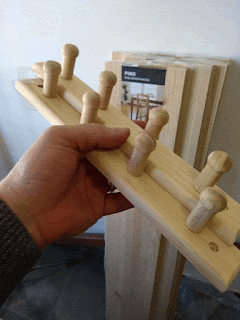 |
| Here's what it looked like when I got it. |
 |
| This was my first look at the frog. |
 |
| The blade and chipbreaker. |
 |
| The front knob. At least it's wood. Notice the front of the casting. |
 |
| The casting. I don't like there being Japanning on the parts that touch the frog, but I left it for now. |
 |
| Blade assemblies: English Stanley on the top, Record on the bottom. |
To tune this up I ran the edge on my stones until I had a nice flat all the way across,
Then I rounded and polished the front of the chipbreaker to make it easy for the shavings to glide past it.
 |
| Perfect! |
 |
| Left - after the vinegar and salt treatment, right - before. |
 |
| The blade adjustment wheel shined up nice, too. |
 |
| Shellac looks nice. |
 |
| Here is how it turned out. |
 |
| The other side. The blue Japanning is growing on me. |
 |
| Wispy shavings. |
I have to say it again.
WOW!
This plane really surprised me. It works fantastic.
I expected it to work well after my experience with the Stanley. But I was expecting the blade to be of lesser quality, or for it to chatter or something.
None of that.
I was a bit worried about the blade being in bad enough shape that shavings would get under the chipbreaker. I did have to resort to using the ruler trick to avoid spending two days lapping the back. That didn't happen, however. It is as good of a blade assembly as any I have.
This next part might sound a bit snooty and wonkish, but if you use oilstones to sharpen you will know what I mean:
The steel in the blade is superb. A lot of what I base that on is how it "feels" on the stone, as well as the sound it makes. Both when sharpening and when planing wood. This is one reason I don't like A2 steel and waterstones. Not because they don't work well, but that "feel" isn't there.
The Stanley blade feels course. Even on my finest stone. And when I plane wood, it gives a raspy, hollow sound. It works great while it is sharp, but it must be sharpened often.
The Ray Iles blade I have is superb O2 steel, and it sharpens up very nice. It sits very solid in the plane and the noise it makes is very satisfying. I must say that I didn't try this blade in the Record yet.
The Record blade has a really nice, slick feel on the stones. It sharpens up to a razor edge in no time, and it seems to stay sharp a long time. I would guess longer than the Ray Iles blade. It's amazing! And paired with that beefy stock chipbreaker the blade assembly is fantastic. The sound the plane makes when cutting wood is very satisfying.
I used this plane to get to know it exclusively during my humidor build. After that I finished a shelf and started another project. I've had my choice of three No. 4 smoothers to use for these projects, and I found myself reaching for the Record every time.
 |
| Stanley type 12, English Stanley, Record. |
I'll certainly have to do some more playing around with these planes to see which one winds up permanently in my tool chest. But I wouldn't be surprised if it was this Record.
I'd love to hear what you think of your Record plane, or any plane for that matter.
I've looked at three planes so far, and you can find my thoughts on the Stanley USA type 12, and a Stanley made in England.
Will there be more?
Perhaps.






































